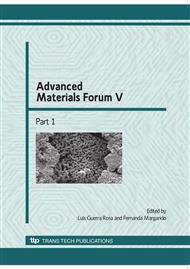[1]
G. Martins, D. Ribeiro, D. Pacheco, J.V. Cruz, R. Cunha, V. Gonçalves, R. Nogueira, A.G. Brito: Appl. Geochem. Vol. 23 (2008), p.2171.
Google Scholar
[2]
R.M. Unnithan, V.P. Vinod, T.S. Anirudhan: J. Appl. Poly. Sci. Vol. 84 (2002), p.2553.
Google Scholar
[3]
D. Ribeiro, G. Martins, R. Nogueira, J.V. Cruz, A.G. Brito: Chemosphere Vol. 70 (2008), p.1256.
Google Scholar
[4]
D.R. Kioussis, F.W. Wheaton, P. Kofinas: Aquaculture Eng. Vol. 19 (1999), p.163.
Google Scholar
[5]
T. Hano, H. Takanashi, M. Hirata, K. Urano, S. Eto: Water Sci. Technol. Vol. 35 (1997), p.39.
Google Scholar
[6]
D. Donnert, M. Salecker: Water Sci. Technol. Vol. 40 (1999), p.195.
Google Scholar
[7]
E.W. Shin, J.S. Han: Environ. Sci. Technol. Vol. 38 (2004), p.912.
Google Scholar
[8]
L.J. Thibodeaux, V.J. Bierman: Environ. Sci. Technol. Vol. 37 (2003), p. 252A.
Google Scholar
[9]
V. Bounor-Legaré, C. Angelloz, P. Blanc, P. Cassagnau, A. Michel: Polymer Vol. 45 (2004), p.1485.
DOI: 10.1016/j.polymer.2003.12.027
Google Scholar
[10]
T. Saegusa: Pure & Appl. Chem. Vol. 67 (1995), p. (1965).
Google Scholar
[11]
M.K. Harrup, M.G. Jones, L. Polson, B. White: J. Sol-Gel Sci. Technol Vol. 47 (2008), p.243.
Google Scholar
[12]
A.D. Eaton, L.S. Clesceri, A.E. Greenberg, in: Standard Methods for the Examination of Water and Wastewater 19 th Edition, edited by A. D. Eaton, L. S. Clesceri, A. E. Greenber, chapter, 4 (1995).
Google Scholar
[13]
A.G. Stack, S.R. Higgins, C.M. Eggleston: Geochimica et Cosmochimica Acta Vol. 65 (2001), p.3055.
Google Scholar
[14]
K. Sakadevan, H.J. Bavor: Wat. Res. Vol. 32 (1998), p.393.
Google Scholar
[15]
A.R. Chowdhuri, C.G. Takoudis: Thin Solid Films Vol. 446 (2004), p.155.
Google Scholar
[16]
A. Ortiz, J.C. Alonso, V. Pankov, A. Huanosta, E. Andrade: Thin Solid Films Vol. 368 (2000), p.74.
DOI: 10.1016/s0040-6090(00)00864-6
Google Scholar
[17]
S.J. Wen, T.J. Richardson, D.I. Ghantous, K.A. Striebel, P.N. Ross, E.J. Carnis: J. of Electroanalytical Chem. Vol. 408 (1996), p.113.
Google Scholar


